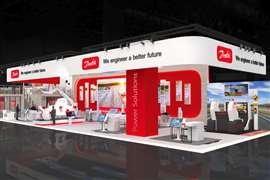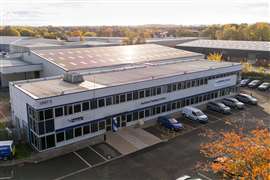Construction equipment autonomy (part 1): How far has onboard tech come?
05 September 2023
Danfoss Power Solutions is known as a specialist electric and hydraulic power solutions provider, but it also has a relatively long history within the autonomous equipment segment.
 Danfoss is no stranger to autonomy, with its Davis research project initiated in 2017. Photo: Danfoss
Danfoss is no stranger to autonomy, with its Davis research project initiated in 2017. Photo: Danfoss
CE caught up with Peter Bleday, head of autonomous vehicles at Danfoss Power Solutions, and asked him to clarify the company’s relationship with autonomy.
Bleday says, “One thing that not everyone realises is that one of our billion-dollar-sized divisions is our controls division, where we have electronics, control valves, etc, that have been working on vehicle control for a long time.
“Out of that electronics has come our PLUS+1 Guide software suite, which has been around since 2004 and is used globally for control software on vehicles.
“For us autonomy was a natural progression as we start to see control systems getting more and more advanced. Autonomy was the obvious next step, adding semi-autonomous or autonomous functions to vehicles.
Ramping up autonomy research
“In around 2017, we started an R&D project…called the Davis Project and it was really built up as a ‘can we do it?’ and ‘what can we do?’
“That R&D team of three or four people continued until early 2020, when the question came from the business side, which was ‘what can we present to customers?’ and ‘how can we help our OEMs start to see this vision?’
“Since my first day, in August 2020, I have really focused on the question of how we help OEMs of any size start to add semi-autonomous or autonomous functions to their vehicles.”
 Peter Bleday is head of autonomous vehicles division at Danfoss Power Solutions. Photo: Danfoss
Peter Bleday is head of autonomous vehicles division at Danfoss Power Solutions. Photo: Danfoss
Danfoss’ journey into autonomy began in earnest with technology for agriculture equipment.
In theory, the challenges of building autonomous functions into an agricultural machine should not compare to those of construction, where sites can be extremely complex and generally more populated.
Bleday doesn’t quite see it that way. He says, “Don’t think necessarily about automating the machine, but think about all the tasks a machine can do and automating those.
“In agriculture you do have a lot of niche machines with one task, so those tasks are easier to automate.
“Because of that, we’ll see what looks like a fully autonomous vehicle much more quickly in those cases.
“In construction, you have excavators, skid steers, compact track loaders, wheel loaders, etc, that are utility vehicles – they don’t just do one task, they do many.
“While there are some vehicles, like a soil compactor or a double drum roller, that might be more single-task oriented, that’s not often the case in construction.
“From a technology standpoint, I don’t think the challenge is much different, it’s more the use cases and the how do you create value.
“The other thing I would say is that the environment around a construction site is very different. Sometimes you might be sharing a road with cars or have just have a few cones separating you.
“Generally, there’s going to be a lot more human interaction around a construction site than around a farm.”
Along with many people working with construction technology, Bleday has his own interpretation of what constitutes true autonomy and about the point in the road that has currently been reached by construction.
He says, “If you think about Level 1 autonomy, it includes simple things like anti-lock brakes.
“The way I think about it is that you’re doing two things: you’re making a mental decision to do something, then physically doing it. With anti-lock brakes, you’re making the mental and physical decision to press the brake pedal; the car is helping you, by making sure it pumps the brakes.
“With Level 2, again, you’re still making the mental decision, but maybe the car was taking some of the physical capabilities on for you. Some of the older cruise controls are a good example of that.
“Level 3, we really think about as the vehicle starting to make decisions for you.
“You might say ‘I want to plough this field’ – the vehicle will figure out what the field size is, maybe avoid obstacles along the way, figure out the best patterns to plough for the area.
“So the vehicle is starting to make decisions, even though the operator may still be on board.
“The way we approach this is by taking some real-world experience and giving that experience to the vehicle. This semi-autonomous piece is pretty synonymous with both on-highway and off-highway.
“Where I think they differ is at Level 4 and Level 5. When we think about Level 4, we think about multiple vehicles running mostly by themselves, but with an operator mostly on site; there might be one or two operators on the site, with three or four vehicles, doing their own jobs.
“Level 5 is fully autonomous; nobody’s there.
“What I would say about today is that we’re seeing a lot of spectrum between Level 1 and 3, across a lot of vehicles, with a bigger push toward Level 3, in construction specifically.
“The reason for this, I think, is that you have an increasing lack of experienced labour, let alone a lack of labour in general.
“Rework, quality of work, things that are costly to a contractor; if you can add some capability onto the vehicle, you can give the vehicle that five years of experience that you don’t have with a novice operator.
“Ultimately, there’s a lot of value around driver assist technology.”
------
In Part 2, coming shortly, Peter Bleday explains more about how autonomous vehicle technology available today is already adding value to an industry challenged by a lack of experienced operators.
POWER SOURCING GUIDE
The trusted reference and buyer’s guide for 83 years
The original “desktop search engine,” guiding nearly 10,000 users in more than 90 countries it is the primary reference for specifications and details on all the components that go into engine systems.
Visit Now
STAY CONNECTED




Receive the information you need when you need it through our world-leading magazines, newsletters and daily briefings.
CONNECT WITH THE TEAM













